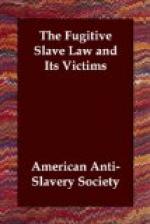he might inquire “whether said alleged
kidnappers were justly held to bail and imprisoned.”
It was so suddenly done that the counsel for
the kidnapped man and for the State of Illinois
had not time to reach Springfield before the men were
discharged and on their way to Missouri. The Grand
Jury of the County (in which Chicago is) had
found a true bill against them, of which the
Sheriff professed to be ignorant, (which was
deemed hardly possible,)—under which bill
they would probably have been convicted and sentenced
to the State Prison. Thus the omnipotent
Slave Power reaches forth its hand into our most
Northern cities, end saves its minions from the
punishment which their lawless acts have justly merited.—Chicago
Daily Tribune, Sept. 21, 1854.
—> The three kidnappers published a statement in the St. Louis Republican of September 26.
HENRY MASSEY, at Philadelphia, September, 1854, was brought before United States Commissioner E.D. Ingraham, claimed by Franklin Bright, of Queen Anne’s County, Maryland, as his slave. Arrested in Harrisburg.
HARVEY, arrested near Cumminsville, Ohio,—escaped,—taken again in Goshen, about ten miles from Cincinnati, and lodged in the jail of that city. An investigation of the case was had before United States Commissioner Pendery, and the slave remanded to the custody of his master.—Cincinnati Commercial, September 22, 1854.
Byberry, Pennsylvania, September 18, 1854. A carriage load of suspicious looking men came to this place in the afternoon. They waited until nightfall, when they burst into the house of a colored family, “seized the man in presence of his wife and another woman, threatening to shoot them if they interfered—dragged him out, beating him over the head with a mace. The poor fellow continued to scream for help until his voice was stifled by his groans; they forced him into their carriage and drove off, before any effectual assistance could be offered.” He was a sober and industrious man, and much respected. His wife was left heartbroken, with one child.—Norristown (Pa.) Olive Branch.
The Frankfort (Ky.) Yeoman, of November 18, 1854, said:—“Kidnapping free negroes in Ohio, and deluding our slaves from their masters to recapture and sell them, is an established profession of a gang located upon the borders of the Ohio River, combining with negro-traders in the interior of this State.” The names of some employed in this business are given, two of whom, having been arrested and imprisoned, threatened to burn the city of Frankfort for interrupting their business.
JANE MOORE, a free colored woman, at Cincinnati, November, 1854, seized in the house of her sister, (Sycamore Street,) beaten, and with the help of a deputy marshal from Covington, Kentucky, carried over to Covington, and lodged in jail, on pretence of her being a fugitive




